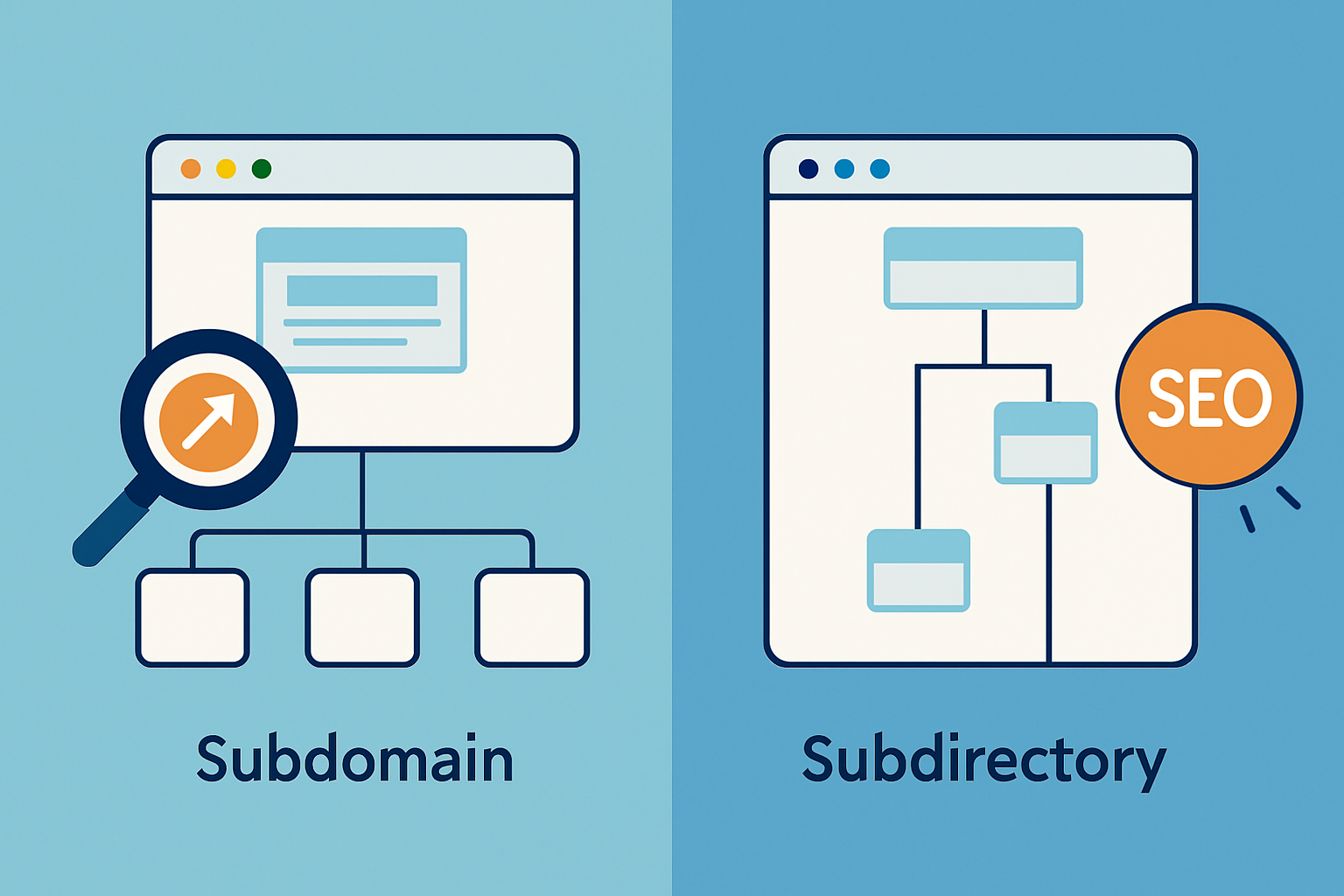Understanding Subdomain SEO For Better Site Structure


Subdomain SEO quietly plays a key role in taming the chaos of complex websites. It can give your search engine visibility a much-needed boost and make navigation a breeze for users. It also helps untangle the overall site structure in a way that makes sense.
So, what exactly does Subdomain SEO involve?
A subdomain is basically a slice of a bigger domain carving out its own corner on the web under the same root domain. Unlike subdirectories which are more like folders inside a site’s main structure, subdomains act like independent websites doing their own thing.
- Subdomains act as an extension of your main domain and follow the format
subdomain.domain.com. - Take
blog.example.comorshop.example.comfor example. They usually serve their own unique content or features like little siblings doing their own thing. - Subdomains are handled separately from the root domain and differ from subdirectories like
domain.com\/blog. - They are handy tools used to split regional sites, product lines or specific services without registering new domains.
What You Should Know About the Effect of Subdomains on SEO
Search engines usually treat subdomains like completely separate websites, each with their own set of ranking signals and indexing routines. This can actually give you the upper hand when fine-tuning your SEO strategy since you can zero in on specific areas more effectively.
- Search engines usually treat subdomains as separate entities, so they end up with their own rankings rather than sharing the main domain’s juice.
- Link authority and domain authority tend to get split apart, meaning each subdomain really needs its own set of backlinks to see any real benefit.
- Crawl budget can get divided too, which might put a cap on how deeply search engines dig into each subdomain’s content.
- It’s best to handle subdomains on a case-by-case basis instead of just hoping links will give a free ride to all of them.
Frequent Misunderstandings about Subdomain SEO That Trip People Up
It is a pretty common notion that subdomains either tank your SEO or are the golden ticket compared to subdirectories. But honestly those black-and-white views tend to lead people down the wrong path more often than not. What really counts is how your site is structured and how search engines actually interpret the links between the parts of your site.
- Subdomains don’t necessarily lose SEO value. When optimized properly they can perform well.
- Search engines crawl and index subdomains thoroughly so you can be confident they aren’t hidden or overlooked.
- Using subdomains is a valid and useful strategy depending on how your content is organized and what your business objectives are.
- Having distinct subdomains doesn’t guarantee separate rankings. Relevance and authority determine success.
Choosing Between Subdomains and Subdirectories Nitty-Gritty
Choosing between subdomains and subdirectories usually boils down to your website’s goals and the kind of content you’re working with as well as your SEO game plan. Subdomains tend to shine when you’re dealing with distinct content or separate business units. Subdirectories generally play nicer when the content is closely knit and shares authority with the main site.
Use subdomains for websites catering to multiple languages or specific regions—a handy way to connect with distinct audiences across the globe.
Product lines or services that need a custom touch and distinct branding usually pay off in spades when given their own subdomains.
Content areas that stand apart like forums or support centers fit perfectly on subdomains. This helps keep user journeys separate and smooth.
Subdirectories tend to shine when content sections are closely intertwined and share link authority and SEO benefits with the main domain—think of it as keeping your ducks in a row.
| Scenario | Use Subdomains | Use Subdirectories |
|---|---|---|
| Multilingual Sites | Creates separate zones for each language, giving you the freedom to tailor content just right | Groups languages neatly into folders, keeping all your SEO ducks in a row |
| Different Product Lines | Lets you carve out distinct branding and SEO vibes for each product, which can be a real win | Shares domain authority across products, a smart move if they are related and you want to play nice |
| Distinct Business Units | Shines when handling independent services or products with their own SEO needs | Can get a bit tricky, as it might confuse visitors trying to find their way around |
| Blog or Content Marketing | Often chosen if the blog stands alone as its own brand, giving it space to breathe | A go-to for simpler navigation and making link sharing a breeze |

Visual comparison highlighting how subdomains and subdirectories organize content differently and impact SEO.
Key Technical Factors to Keep in Mind for Subdomain SEO (Because These Really Make a Difference)
Setting up subdomains comes with a handful of key technical SEO considerations you really don’t want to overlook. Get it right, and it plays a key role in helping search engines properly index and rank every nook and cranny of your website.
- Double-check that canonical tags are spot-on for each subdomain because it’s a handy way to avoid those pesky duplicate content headaches.
- Submit separate sitemap files for every subdomain to search engines. This helps them crawl and index your site more smoothly, like giving them a well-marked map.
- Tackle robots.txt files one by one to control which pages crawlers can access and keep the unwanted ones nicely tucked out of the index.
- Make sure your SSL certificates cover all subdomains so HTTPS security stays rock solid and your visitors continue feeling safe and sound.
Tried-and-True Tips to Boost SEO for Your Subdomains
Really squeeze the most SEO juice out of subdomains by focusing on strong internal links and unique related content with a targeted approach to backlink outreach.
Build strong internal links between your main domain and its subdomains to help share user signals and give search engines a clearer picture of your site structure. It’s like connecting the dots so nothing gets lost in translation.
Make sure each subdomain stands out with unique high-quality content focused on specific topics to avoid keyword overlap that can make your SEO efforts go sideways.
Treat each subdomain like its own kingdom when it comes to backlinks since link authority usually doesn’t transfer automatically. Don’t assume a backlink on one will do all the heavy lifting for the others.
Keep a close eye on rankings, backlinks and crawl health for every subdomain individually using SEO tools like Moz Pro or Mangools. It pays to keep tabs on each one because what works for one might not for another.
How to Measure Success and Tackle the Quirks of Subdomain SEO
Tracking SEO performance for subdomains often means rolling up your sleeves and setting up separate properties in tools like Google Search Console. Catching common indexing or ranking hiccups early on is key.
- Use Google Search Console’s domain and subdomain properties to separate and compare performance data— it’s like giving each part its own spotlight.
- Keep an eye on traffic and rankings for each subdomain to uncover their unique strengths and quirks. A closer look can reveal a lot.
- Jump on crawl errors reported for each subdomain as soon as they appear since a smooth indexing process keeps your SEO engine humming.
- Tackle duplicate content across subdomains with care. Think of it as avoiding stepping on your own toes while combining ranking signals for the best impact.
Further Reading
Unlock Digital Marketing Success with Moz
Struggling to optimize your online presence? Moz is the ultimate Internet Marketing solution, empowering businesses with powerful SEO tools, insightful analytics, and expert guidance. Elevate your digital strategies and outshine the competition.
- Boost organic traffic with data-driven SEO tactics
- Enhance content marketing with expert recommendations
- Gain a competitive edge with comprehensive link analysis








